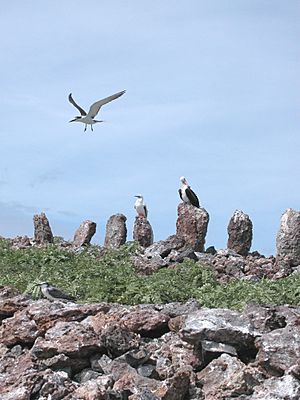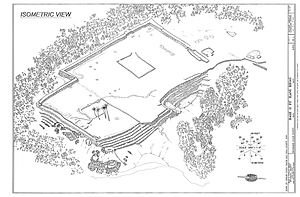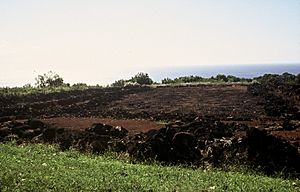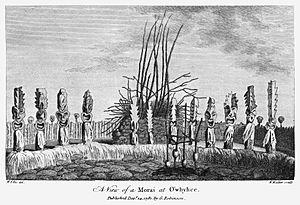Heiau facts for kids
A heiau is an ancient Hawaiian temple. These special places were built in many different ways. Some were simple earth terraces, while others were large stone platforms. Heiau had many purposes. They could be used to help sick people, celebrate the first harvest or fishing catch, ask for rain, or even help with war.
One type of heiau, called a luakini, was used for important ceremonies. These ceremonies sometimes included offerings of animals or plants. After the traditional Hawaiian religion officially ended in 1819, and with the arrival of Christian missionaries in 1820, many heiau were destroyed or left to crumble.
Even today, many people in Hawaii consider heiau to be sacred. Some are not open to the public. Long ago, only chiefs and priests could enter certain heiau. Hawaiian stories even say that the menehunes, a group of legendary small people, built some of these temples. Today, some heiau have been rebuilt and can be visited by the public.
Contents
What Are Heiau?
Heiau were built in many shapes and sizes. Their design depended on what they were used for. Some were simple stone markers. Others were large stone platforms with tall walls around a central area. They could be rectangular, square, or even round.
You could find heiau in many places. They were built on hills, cliffs, flat land, in valleys, and along the coast. Some special fishing shrines, called koʻa, were even built underwater! The size of a heiau often showed how important the person who built it was. Large heiau were built by powerful chiefs, while smaller ones were built by everyday people.
An early missionary named Hiram Bingham I saw a heiau on his travels. He described it as a square of lava rock, about 30 meters (100 feet) on each side. Its walls were about 2.5 meters (8 feet) high and 1.3 meters (4 feet) thick. There was a doorway in the north wall. Outside the temple, there were eight pyramids made of piled lava rock. These pyramids were about 3.6 meters (12 feet) wide and 3.6 to 4.5 meters (12 to 15 feet) tall.
Types of Heiau
There were different kinds of heiau, each with a special purpose.
Luakini Heiau
The luakini poʻokanaka were very large heiau. Only the highest chiefs, called Aliʻi nui, could use these temples. If other chiefs or common people built this type of heiau, it was seen as an act of rebellion. These large heiau were often built along coastlines, inland, or on mountainsides.
The biggest heiau on Oahu is Puʻu O Mahuka. It covers almost two acres of land. This heiau was used for religious ceremonies. It was also used to track fire signals from the Wailua Complex of Heiaus on Kauai.
Marae Heiau
An older style of heiau can be found on Nihoa and Necker Island. These are often called marae. They look similar to structures found in other parts of Polynesia. These marae usually have stone platforms, sometimes with different levels. Stone uprights are often placed near the edges of the platforms.
Important Heiau Sites
Many of the heiau that are still preserved today were war temples from later periods of Hawaiian history. An example is Pu'ukohola Heiau National Historic Site. These temples usually have large stone platforms. Various buildings were constructed on these platforms.
These buildings housed priests, sacred drums, and special items. They also held statues representing the linked to that temple. There were also altars, called Ahu, where offerings were made. Heiau were very sacred places. Only the kahuna (priests) and certain sacred ali'i (high chiefs) were allowed to enter.
The largest known heiau is Hale O Pi'ilani Heiau. It is a huge platform, about three acres in size. Its walls are 15 meters (50 feet) high. This heiau is located in Hāna on Maui. It was built for a chief named Pi'ilani around the 13th century.
Agricultural Heiau
Some heiau were built for farming. These were often called Hale-o-Lono, named after the god of fertility. You can find examples on Oʻahu. The Kaneaki heiau in Makaha has been fully restored. The Pahua heiau in Hawaii Kai has been partly restored. The Kaneaki heiau was built in the 17th century. It had grass and thatched huts used for prayer and meditation.
Healing Heiau
The ruins of a healing heiau, called Keaiwa ("the mysterious"), are located at the entrance to Keaiwa State Park in ʻAiea. This type of heiau was used to help people who were sick.
Places of Refuge
Puʻuhonua o Honaunau is a special place in South Kona on the island of Hawaiʻi. It was a place of refuge. If someone broke a sacred law or was in danger, they could find safety here. This site includes a heiau complex within its sacred grounds.
Because heiau land was sacred, later generations often added to the original structures. The purpose of a heiau could also change over time. For example, Ulupo heiau in Kailua on Oʻahu is said to have been built by the menehune a very long time ago. It is thought to have been used first for farming and later as a luakini.
End of Heiau Use
The ancient Hawaiian system of sacred laws, called kapu, was ended in October 1819 by Kamehameha II. This change meant that heiau were no longer used for worship and offerings. A period known as the ʻAi Noa, or "free eating," followed.
When missionaries arrived in 1820, many Hawaiian chiefs converted to Christianity. This included important figures like Kaʻahumanu and Keōpūolani. It took 11 years for Kaʻahumanu to make laws against traditional Hawaiian religious practices. All heiau were officially abandoned. Most were destroyed over the years, often to make way for sugar cane fields. However, some families who were responsible for the heiau have continued to care for them.
List of Heiau

Hawaii
- Puʻukoholā Heiau
- Moʻokini Heiau
- ʻAhuʻena Heiau
- Mailekini Heiau
- Hale o Kapuni Heiau
Maui
- Loaloa Heiau
- Hale O Piʻilani Heiau
- Haleki'i-Pihana Heiau State Monument
Molokai
Oahu
- Hale O Papa [Mother Earth Heiau in Halawa]
- Hoʻolonopahu Heiau
- Kaneʻaki Heiau
- Pahua Heiau
- Pahukini Heiau
- Keaiwa Heiau
- Puʻu o Mahuka Heiau
- Ulupo Heiau
Kauai
- Wailua River State Park
- Kaulu Paoa Hula Heiau
- Kaulu-o-Laka Hula Heiau
Niihau
- Kauwaha Heiau
- Pahau Heiau
- Pueo Heiau
- Kaunupou Heiau
- Kaunuapua Heiau
- Puhi Ula Heiau
See also
 In Spanish: Heiau para niños
In Spanish: Heiau para niños




